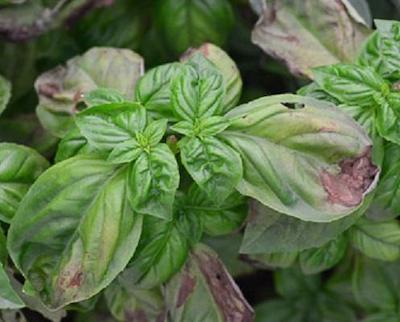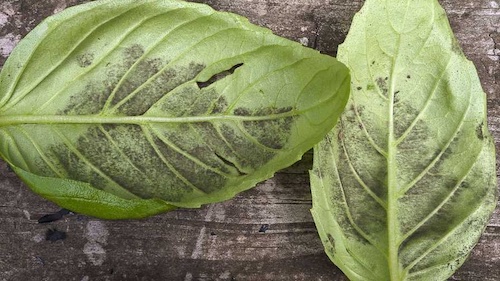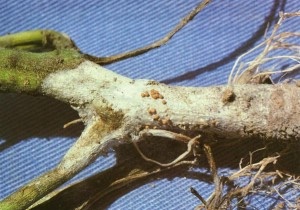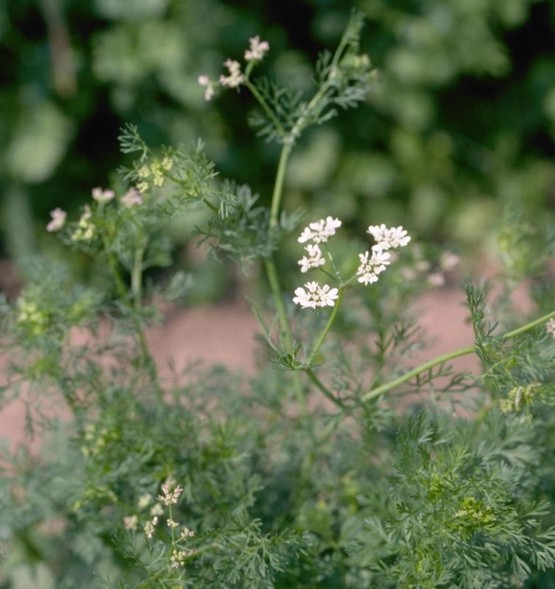Diseases of Herbs
by Christian Henkel, Fairfax Master Gardener Intern

Basil Downy Mildew
Herbs are generally thought of as disease-free plants. But, there are many diseases that can affect one’s herbs, which can lead to discoloration, wilting, rotting of plant parts and even death of the plant. The first and most important step in the process of treating one’s plants is identifying what the disease is, so that you can proceed to taking the next steps of treating the infection. Hopefully, you will learn how to identify what the source of the problem is with whatever disease your plant has.

Basil leaves infected with downy mildew
Basil Downy Mildew
This infectious disease causes the upper sides of basil leaves to turn a pale yellow color while causing the underside of the leaves to develop a velvety grey. This mildew is caused by a water mold, Peronospora belbahrii. It can spread by means of seeds, transplants or fresh leaves. Although it does best in warm, humid conditions, it can still infect and produce spores at temperatures as low as 59 degrees (15ºC).
Southern Blight
This lethal fungal disease is caused by the fungus, Sclerotium rolfoii. It infects not only herbs, but many other herbaceous perennials. In fact, it affects over 500 plant species. It is active only in hot weather, occurring most commonly in the tropics and subtropics.

Southern Blight on Root
It causes the lower leaves of the plant to take on a water-soaked appearance or it can cause water-soaked spots on the plant’s lower stems. Infected plants will usually yellow and wilt within a few days after being infected. Other symptoms of this disease include rotting fruits, rotting crowns and rotting roots. Mycelia may also grow from the infected tissue and spread from the plant to the soil surface.
This fungal disease can be transmitted by the movement of soil and plant debris infected with this disease, through infected plants, through contaminated irrigation water and by using infected tools.
Bolting
Bolting is when plants develop flower and go to seed too early in their development. Bolting occurs when plants are exposed to prolonged cold or hot temperatures or to daylight for long hours. Plan ahead of time to plant them during the most favorable conditions; avoid planting your plants under these unfavorable conditions. When cilantro bolts in hot weather, you get flowers and seed which can be harvested and saved as coriander seeds.
Overwatering
Soil that retains water for prolonged periods of time, pooling water due to a slope or overwatering one’s plants can all cause permanent damage to herbs. These can all damage herbs because excess water in the soil reduces the amount of space available for oxygen, causing damage to any fine roots and resulting in the ability of the plant to absorb water.
Symptoms of overwatering plants include wilting or yellowing of the leaves on the lower and inner portion of plants. If the plant is continuously exposed to excess water, it may go through more serious symptoms such as scorch, leaf drop and/or death.

Cilantro bolting
Plants should therefore only be watered when needed. The factors to be considered for when to water plants include what stage of growth they are in, what time of year it is, the humidity level and the temperature.
Protecting perennial and biennial herbs from harsh winter conditions is very important for their survival, as many herbs have shallow roots, making them more susceptible to heaving (occurs when they are pushed out of the soil) when the soil freezes and then thaws.
When mulching, use straw, oak leaves or evergreen boughs 4 inches in height to protect the plants from the potential freezing of the soil. You should mulch the ground after it has frozen in early winter. To avoid any early frost damage to the plants, you should remove the mulch after the plant(s) have shown signs of growth in early spring.
You have now learned some diseases as well as some abiotic factors that cause damage to herbs. You are ready to identify basil downy mildew, southern blight, bolting, overwatering, and water injury so that you can take the second step of taking care of your plant by treating the plant. Good luck on this project and remember to always follow the directions completely as stated on the packaging of the product for any treatment you use.
- References
- Care of Herbs and Starting Herbs from Seed, University of Maryland Extension
- Herb Problems, University of Maryland Extension
- Bolting, University of California Integrated Pest Management
- Basil Downy Mildew, University of Minnesota Extension
- Southern Blight, Texas A&M Agrilife Extension